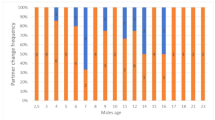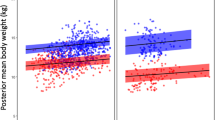Abstract
The authors analyzed the breeding characteristics of a colony of Ototylomys phyllotis (big-eared climbing rat) from Campeche, México, that was bred in captivity for 6 y. The big-eared climbing rat is a reservoir of Leishmania (Leishmania) mexicana, a causal agent of localized cutaneous leishmaniasis on the Yucatán Peninsula. The colony had been established to facilitate studies analyzing the effectiveness of O. phyllotis as an experimental model for L. (L.) mexicana. The authors describe the housing and husbandry of the colony, the procedures used for mating the animals and the behavior of the animals during mating. They report that the animals showed social behavior and could be bred successfully. Most breeding pairs successfully produced litters; some pairs produced more than one litter. The authors also report data for other parameters, such as the interval between pairing and birth or between births of consecutive litters, litter size, survival to weaning, the timing of sexual maturity and the effects of breeder age on breeding success.
This is a preview of subscription content, access via your institution
Access options
Subscribe to this journal
We are sorry, but there is no personal subscription option available for your country.
Buy this article
- Purchase on Springer Link
- Instant access to full article PDF
Prices may be subject to local taxes which are calculated during checkout

Similar content being viewed by others
References
Desjeux, P. Leishmaniasis. Nat. Rev. Microbiol. 2, 692 (2004).
Gramiccia, M. & Gradoni, L. The current status of zoonotic leishmaniases and approaches to disease control. Int. J. Parasitol. 35, 1169–1180 (2005).
Chablé-Santos, J.B., Van Wynsberghe, N.R., Canto-Lara, S.B. & Andrade-Narváez, F.J. Isolation of Leishmania (L.) mexicana from wild rodents and their possible role in the transmission of localized cutaneous leishmaniasis in the state of Campeche, Mexico. Am. J. Trop. Med. Hyg. 53, 141–145 (1995).
Andrade-Narváez, F.J. et al. Seasonal transmission of Leishmania (Leishmania) mexicana in the state of Campeche, Yucatan Peninsula, Mexico. Mem. Inst. Oswaldo Cruz. 98, 995–998 (2003).
Lainson, R. & Strangways-Dixon, J. The epidemiology of dermal leishmaniasis in British Honduras: Part II. Reservoir-hosts of Leishmania mexicana among the forest rodents. Trans. R. Soc. Trop. Med. Hyg. 58, 136–153 (1964).
Disney, R.H.L. Observations on a zoonosis: Leishmaniasis in British 463 Honduras. J. Appl. Ecol. 5, 1–59 (1968).
Canto-Lara, S.B., Van Wynsberghe, N.R., Vargas-González, A., Ojeda-Farfán, F.F. & Andrade-Narváez, F.J. Use of monoclonal antibodies for the identification of Leishmania spp. isolated from humans and wild rodents in the state of Campeche, Mexico. Mem. Inst. Oswaldo Cruz. 94, 305–309 (1999).
Van Wynsberghe, N.R., Canto-Lara, S.B., Sosa-Bibiano, E.I., Rivero-Cárdenas, N.A. & Andrade-Narváez, F.J. Comparison of small mammal prevalence of Leishmania (Leishmania) mexicana in five foci of cutaneous leishmaniasis in the State of Campeche, Mexico. Rev. Inst. Med. Trop. São Paulo 51, 87–94 (2009).
Van Wynsberghe, N.R., Canto-Lara, S.B., Damián-Centeno, A.G., Itzá-Ortiz, M.F. & Andrade-Narváez, F.J. Retention of Leishmania (Leishmania) mexicana in naturally infected rodents from the State of Campeche, Mexico. Mem. Inst. Oswaldo Cruz. 95, 595–600 (2000).
Lawlor, T.E. A systematic study of the rodent genus Ototylomys. J. Mammal. 50, 28–42 (1969).
Jones, J.K. Jr., Genoways, H.H. & Lawlor, T.E. Annotated checklist of mammals of the Yucatán Peninsula, Mexico. II. Rodentia. Occas. Papers Mus. Texas Tech. Univ. 22, 1–24 (1974).
Nowak, R.M. Walker's Mammals of the World vol. 1, 5th edn. (Johns Hopkins University Press, Baltimore, 1991).
Lawlor, T.E. Ototylomys phyllotis. Mammalian Species. 181, 1–3 (1982).
Reid, F.A. A Field Guide to the Mammals of Central America & Southeast Mexico. (Oxford University Press, New York, 1997).
Birney, E.C., Bowlers, J.B., Timm, R.M. & Williams, S.L. Mammalian 494 distributional records in Yucatán and Quintana Roo, with comments on reproduction, structure, and status of peninsular populations. Occas. Papers Bell Mus. Nat. Hist., Univ. Minn. 13, 1–25 (1974).
Helm, J.D. III. Reproductive biology of Ototylomys (Cricetidae). J. Mammal. 56, 575–590 (1975).
Hernández-Betancourt, S.F., Cimé Pool, J.A., Medina Peralta, S. & González-Villanueva, M.L. Fluctuación poblacional de Ototylomys phyllotis Merriam, 1901 (Rodentia: Muridae) en una selva mediana subcaducifolia del sur de Yucatán, México. Acta Zool. Mex. 24, 161–177 (2008).
Biology of Peromyscus (Rodentia). (ed. King, J.A.) (American Society of Mammalogists, Special Publication No. 2, 1968).
Acknowledgements
We thank the Centro de Investigaciones Regionales of the Universidad Autónoma de Yucatán for the use and administration of the animal care facility and Dr. Ian Dennis for editing the manuscript. This study was supported by a grant from the INDP/World Bank/WHO Special Programme for Tropical Diseases Research (RCS/TDR/WHO 90024) and a grant of the World Health Organization (RC/TDR/WHO ID-900248e).
Author information
Authors and Affiliations
Corresponding author
Ethics declarations
Competing interests
The authors declare no competing financial interests.
Rights and permissions
About this article
Cite this article
Itzá-Ortiz, M., Van Wynsberghe, N., Sosa-Bibiano, E. et al. Reproductive characteristics of a captive colony of big-eared climbing rats (Ototylomys phyllotis). Lab Anim 40, 246–251 (2011). https://doi.org/10.1038/laban0811-246
Received:
Accepted:
Published:
Issue Date:
DOI: https://doi.org/10.1038/laban0811-246



